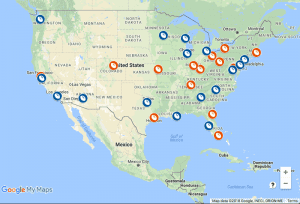It was an informal agreement between the two governments. Under this agreement, Japan would prevent all Japanese immigrants from coming to the United States. On the other hand, the United States agreed to end discriminatory policies and guarantee equal rights for Japanese citizens in California. The agreement worked and defused tensions between the two nations. The Gentleman`s Agreement of 1907 was an agreement between the United States of America and Japan. It was called the Gentleman`s Agreement because the two parties had not signed a formal agreement and it was hoped that both would honor it, just as two gentlemen would honor an informal agreement. Concessions were agreed a year later in a six-point note. The agreement was followed by the admission of students of Japanese origin to public schools. The adoption of the 1907 agreement stimulated the arrival of “wives of images”, marriages of convenience made remotely through photos. [11] By establishing distant marital ties, women who wanted to emigrate to the United States could obtain a passport and Japanese workers in America could obtain a partner of their own nationality.
[11] As a result of this provision, which helped close the gender gap within the Community from a ratio of 7 men to every woman in 1910 to less than 2:1 in 1920, the Japan-U.S. population continued to grow despite immigration restrictions under the Agreement. The gentlemen`s agreement was never included in a law passed by the U.S. Congress, but was an informal agreement between the United States and Japan enacted by unilateral action by President Roosevelt. It was struck down by the Immigration Act of 1924, which legally prohibited all Asians from emigrating to the United States. [12] On the other hand, the Japanese government wanted to protect his honor as a national power. It therefore called on the US government to take appropriate measures against such discriminatory policies. All this eventually led to the Gentleman`s Agreement of 1907. Japan was willing to limit immigration to the United States, but was deeply hurt by San Francisco`s discriminatory law, which was specifically directed against its population. President Roosevelt, who wanted to maintain good relations with Japan as a counterweight to Russian expansion in the Far East, intervened.
While the U.S. ambassador was reassuring the Japanese government in February 1907, Roosevelt summoned the mayor and school board of San Francisco to the White House and persuaded them to lift the segregation order, promising that the federal government itself would address the immigration issue. On February 24, the gentlemen`s agreement with Japan was reached in the form of a Japanese note agreeing to deny passports to workers who wished to enter the United States and to recognize the U.S. right to exclude Japanese immigrants who hold passports originally issued in other countries. This was followed by the official withdrawal of the San Francisco School Board`s ordinance on March 13, 1907. A final Japanese note dated 18 Feb. 1908 rendered the Gentlemen`s Agreement fully effective. The agreement was replaced by the Exclusionary Immigration Act of 1924.
President Roosevelt had three goals to resolve the situation: to show Japan that California`s policies did not reflect the ideals of the entire country, to force San Francisco to repeal segregation policies, and to find a solution to the problem of immigration to Japan. Victor Metcalf, Minister of Trade and Labour, was sent to investigate the problem and force the repeal of the policy. This did not succeed because local officials wanted Japan to be excluded. Roosevelt tried to put pressure on the school board, but she didn`t want to budge. On February 15, 1907, the parties reached a compromise. If Roosevelt could ensure the suspension of Japanese immigration, the school board would allow Japanese-American students to attend public schools. The Japanese government did not want to harm or humiliate its national pride as the Qing government did in China in 1882 through the Chinese Exclusion Law. The Japanese government has agreed to stop issuing passports to workers who attempt to enter the United States unless those workers come to occupy a previously acquired house to join a relative; spouse; or child, or to take active control of a previously acquired farm. [10] Tensions in San Francisco had risen, and since Japan`s decisive victory over Russia in 1905, Japan had demanded equivalent treatment. The result was a series of six banknotes issued between Japan and the United States from late 1907 to early 1908. The immediate cause of the agreement was anti-Japanese nativism in California.
In 1906, the San Francisco Board of Education passed an ordinance requiring children of Japanese descent to attend separate and separate schools. At the time, Japanese immigrants made up about 1 percent of California`s population, many of whom had immigrated in 1894 under a treaty that ensured free immigration from Japan. [3] [6] On April 18, 1906, the San Francisco, California Board of Education separated all students of Japanese descent from the Oriental Public School for Chinese, Japanese, and Koreans. Japanese Americans were outraged by what they believed to be a violation of the 1894 treaty that guaranteed them the right to immigration. When the problem subsided, the Japanese and U.S. governments stepped in to maintain diplomatic peace. The 1907 Gentleman`s Agreement collection in DIVA brings together primary source documents such as telegrams, letters, and confidential memos from 1906 to 1908 that detail the discussions of Theodoore Roosevelt, Elihu Root, Kazuo Matsubara, and others. Newspaper clippings and magazine articles in the United States and Japan show the real impact of their decisions.
(continued) The agreement stipulated that Japanese immigrants who were already in the United States could bring their wives, parents, or children from Japan to the United States. This provision allowed Japanese men in the United States to marry a partner in Japan and then bring him to the United States. As a result, the Japanese immigrant population in California continued to grow. Eventually, the U.S. Congress passed the Immigration Act of 1924. This law prohibited all Asians from emigrating to the United States of America. The increase in Japanese immigration, which was intended to replace partially excluded Chinese farm workers, met with concerted resistance in California. To appease Californians and avoid an open break with Japan`s rising world power, President Theodore Roosevelt brokered this diplomatic agreement, under which the Japanese government took responsibility for drastically reducing Japanese immigration, especially workers, so that Japanese-American children could continue to attend integrated schools on the West Coast. However, family migration could continue, as Japanese-American men with sufficient savings could bring women through arranged marriages (“picture brides”), their parents, and minor children. As a result, the Japan-U.S. population was more gender-balanced than other Asian-American communities and continued to grow through natural growth, resulting in increased pressure to end their immigration and further reduce residents` rights.
The Gentlemen`s Agreement of 1907 (日米紳士協約, Nichibei Shinshi Kyōyaku) was an informal agreement between the United States of America and the Empire of Japan, under which the United States did not restrict Japanese immigration and did not allow Japan to emigrate further to the United States. .


